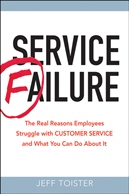DHL Express to take "the DHL" out of the shipping business
 Jeff Toister
Jeff Toister  Tuesday, November 18, 2008 at 4:03PM |
Tuesday, November 18, 2008 at 4:03PM | DHL announced last week it plans to pull out of the domestic express delivery business within the US. I haven't had much good to write about DHL (see my November 2 post), but this one takes the cake. A recent BusinessWeek article quotes John Mullen, CEO of DHL Express, as saying, "It's hard to see what could have been done that would have led to a different result."
Recently, I saw a keynote address from a former Navy fighter pilot who is now a motivational speaker with a group called Afterburner. The speaker stressed that "debriefing after the mission" is one of the most crucial, but often overlooked, steps to achieving high performance. With this in mind, here is what we can learn from the demise of DHL Express. i
- Be careful what (and how) you outsource
- Beware of icebergs
- Listen to your customers
Be careful what (and how) you outsource
The delivery driver plays a crucial customer service and public relations role in a delivery company. He or she typically visits clients every day, drives a mobile billboard (i.e. branded delivery truck), and is the starting and ending point for package delivery. In short, the delivery driver is critical to clients' perceptions of a delivery service.
At DHL, delivery is outsourced in many (if not all markets). The contractors driving DHL trucks in San Diego are often aggressive drivers, making a poor impression in traffic. (I live near DHL's San Diego hub.) I've also heard many reports of these contract drivers being surly and unpleasant with clients.
The lesson here is be careful when you outsource. Outsourcing may save a few pennies, but could cost you a few dollars if the function is vital to your success. At the very least, you should hold contractors to your own service standards if they have regular contact with your customers.
Beware of icebergs
An iceberg is typically bigger and more dangerous below the surface. In business, what you can see (above the surface) may indicate much bigger problems below the surface. A few years ago, I was a Customer Service Manager at a catalog company that shipped most of its orders via Airborne Express (now DHL). The Airborne Express order tracking system was error-prone and inaccurate, especially when compared to their competitors, UPS and FedEx. As a result, they'd often lose shipments mid-route and try to tell us we never shipped the package. Typically, the package would turn up in one of their warehouses a few days later.
These situations should have pointed DHL towards operational challenges that urgently needed fixing. Instead, they were written off as one-time flukes. Companies who ignore or do not investigate icebergs risk seeing their strategies fail, their productivity decline, and their customers defect.
Listen to your customers
DHL's recent ad campaigns and CEO John Mullen's comments show how out of touch DHL is with their customers. In classic Dilbert fashion, the marketing department decided to promote something (outstanding customer service) that operations couldn't deliver. (Ha ha, no pun intended, but it worked.)
Your customers will tell you where you are doing well and where you can improve. If you are going to promote a particular benefit in your advertising, you would do well to first ensure you can deliver that benefit. The trick is to resist the urge to assess your capabilities through internal measures alone, but to instead listen to the voice of your customers.




Reader Comments